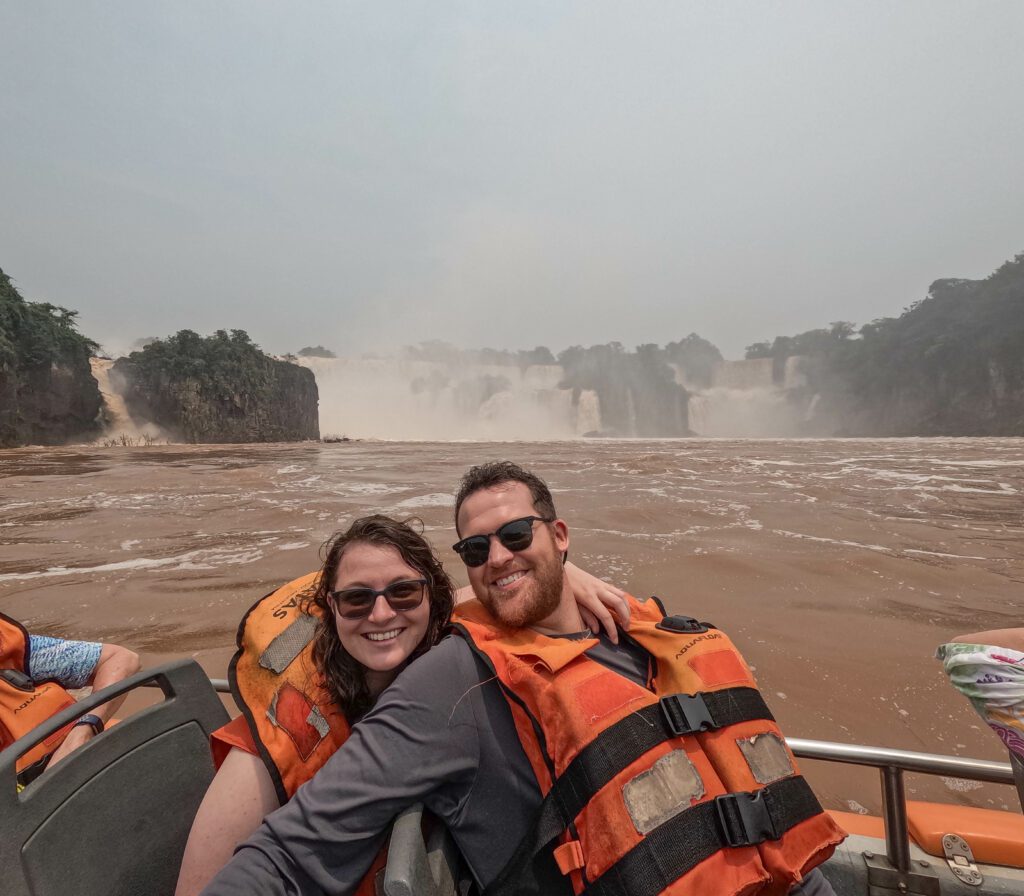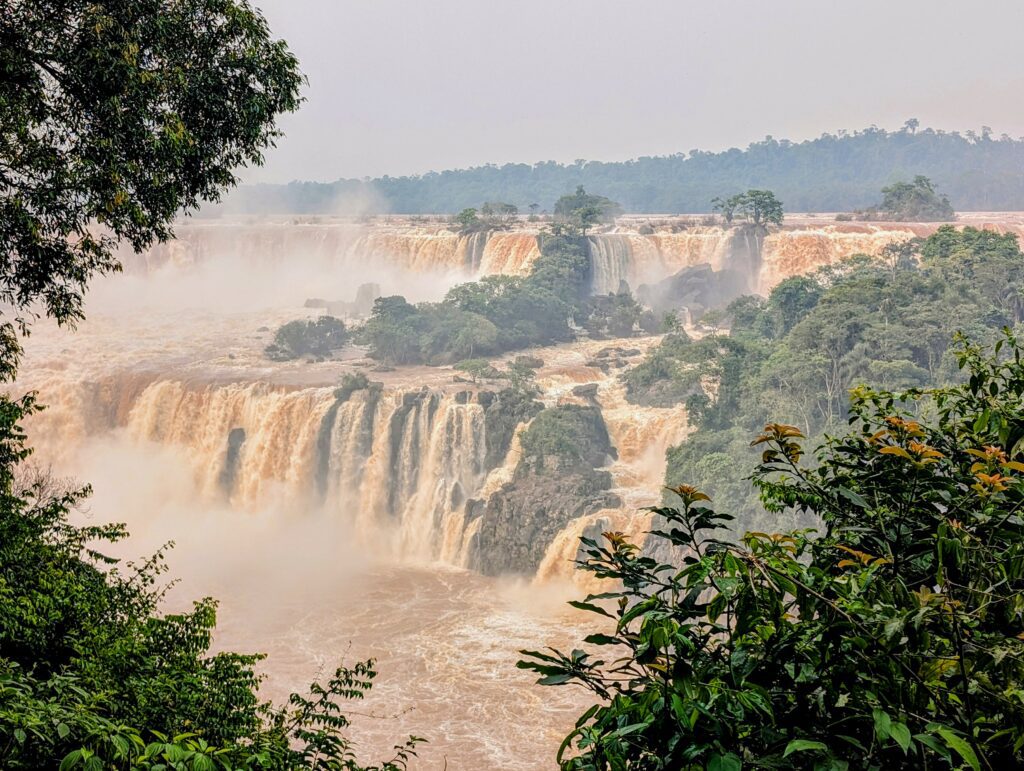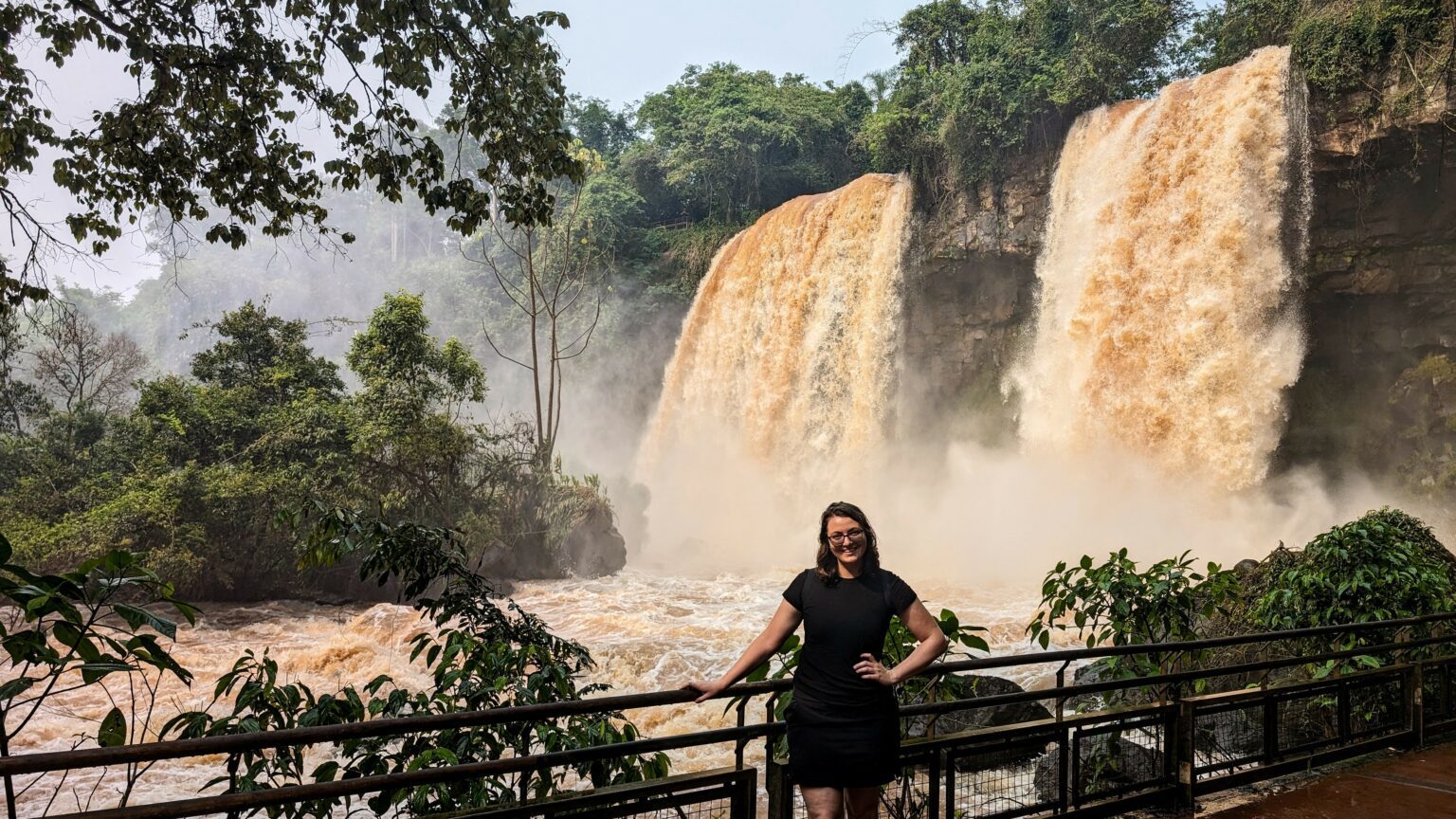The Iguazu area is a protected area near the borders of Paraguay, Brazil and Argentina and is most famously known for its immense waterfall. It is one of the biggest waterfalls in the world, made up of 160 – 200 individual falls, to create an incredibly powerful landscape.
Over 1.5 million visitors come to the park every year. There are worries that the quantity of visitors will damage the ecosystem of this area. In addition, climate changes have had an adverse effect on the area.
This year, heavy rains in Brazil caused record levels of flooding in the Iguazu river. At its peak, the waterfall flow was 16 times more than the normal the amount of water. Two weeks after its peak, when we visited, the water levels were still incredibly high, carrying 5 times the normal amount. Because of this, some of the walkways on the Argentine side of the park were swept away and destroyed. This will take at least a year to repair and has eliminated one of the biggest attractions on this side of the park.
You will see the effects of this flooding from an aesthetic perspective in our photos, especially if you compare them to some other blogs. The water was a red-brown color. The force of the water picked up more dirt than normal, causing this change in color. In addition, the visibility of the waterfall was hindered by the amount of splashing and mist that resulted from the increase in water flow.
The Logistics of Visiting the Iguazu Falls

When to Visit Iguazu National Park
The best time of year to visit is March to May or August to October. March to May is at the tail end of the summer months. The weather starts to cool down and it is the dry season for the region. (Although, it rains truly year round here). August to October is the spring season and the weather could be really pleasant to walk around. We decided to go in mid November (some websites said November was still a good time to go). It was definitely hot and humid, maybe unseasonably so, but it did not prevent us from enjoying the views. We truly felt the effects of global warming. Locals told us that the area was getting warmer sooner and staying warmer longer. Keep this in mind when reading through past blogs to determine the best time to visit.
What to Pack to Visit the Parks
You will get wet! There is no way around it, especially if you take the exciting boat tour at either of the parks or just walk through some of the walkways of the Brazilian side (see below). We wore Teva sandals for the grip, bathing suits, and quick-dry clothes. If you don’t like being wet, bring a change of clothes in a dry bag. We enjoyed getting sprayed down by the waterfalls to cool down in the heat.
Puerto Iguazu or Foz do Iguaçu?
Personally, we stayed in Puerto Iguazu because it is significantly less expensive than Brazil due to the economic conditions of Argentina at this time. (You can read more about this here.) We found that getting buses to either side of the falls was straightforward and it was pretty easy to cross from Puerto Iguazu to Foz do Iguaçu.

You can definitely fly into either city. While we have the information in 2023 for navigating the Iguazu National Park from the Argentine side, we recommend going to the local tourist information center in Foz do Iguaçu to get more information, if you are staying on the Brazilian side. It’s a tourist hub so they will have answers for you!
Day 1: Arriving in Puerto Iguazu and Exploring the Town
Getting to the Iguazu Area
There are two ways to get to the Iguazu area: bus or flying. You can do this from both the Brazil and Argentine sides.
The bus from Buenos Aires will take about 17 hours, the bus from Sao Paulo will take about 16 hours, and the bus from Rio de Janeiro will take 25 hours. These buses are typically quite comfortable and you can upgrade your seat to make the journey easier.

Flying into Puerto Iguazu or Foz do Iguaçu airports made the journey faster, but at a price. From the airport, we were able to get a taxi to our accommodations and there was also a private transportation company at the Puerto Iguazu airport to go to the town center. (We flew out of Foz do Iguaçu and used a taxi to get to the airport there. There is a bus that can take you from the airport to the city center but a taxi was not an unreasonable price. You can use your Uber app to gauge the price of the taxi.) You definitely do not need to have a car to visit this area!
Where to Stay
In Puerto Iguazu, we stayed in a short-term rental. It was similar to a Bed & Breakfast and felt incredibly cozy. We chose it due to its proximity to the bus station. This made our mornings easy to get on the first bus to get to the park before too many people arrived. It was also a walking distance to most of the restaurants.
A few things to consider when determining where to stay in Puerto Iguazu:
- Look for something with air conditioning. It can get hot and humid and, because of the humidity, it does not cool down in the evening
- If you need Wi-Fi, consider a hotel over a short-term rental. In the more rural locations, Wi-Fi and service can be spotty and a hotel will have the infrastructure to provide you the Wi-Fi. Read the reviews of a location prior to booking since this is something that people will complain about if it doesn’t work
- Look at the location of the accommodation relative to the main bus stop.
What is there to do in Puerto Iguazu?

After we got settled at our accommodation, we decided to walk around the town and explore a little. This area is at an incredibly interesting intersection in South America. Three countries intersect at this point: Paraguay, Brazil, and Argentina. There is a viewpoint in Puerto Iguazu to see the two other countries across the river. You can take a 30 minute walk from the center of town to see it.

There are also boats along the river that do a one hour ride on the river. People along this path can tell you about this boat ride. It is typically in the late afternoon.
Ultimately, it was so hot that we just wanted to get back to our accommodations and cool down in front of the AC. (We didn’t know that it would be out for a few hours due to a power outage – which may happen in these more remote areas!)
Day 2: The Iguazu Falls on the Argentina Side
We split up the park into two days, one for the Argentina side and one for the Brazil side. We started in Argentina because the weather was nicer on the first day and the Argentina side is larger than the Brazil one.

This side of the park put us above the waterfalls. We were able to walk on boardwalks on the edge of the falls, looking down and seeing their power below our feet. Two of the three circuits were open for us. (One was closed and damaged due to the flooding.)

We ended the day with a thrilling boat ride getting close to the waterfalls from the river. If we hadn’t done the boat ride, we would have ventured into the rainforest on a hike. We spent the full day on this side. You can read more about it here.
Day 3: Iguaçu National Park on the Brazilian Side
For the second day, we spent the day at the Brazilian part of the waterfalls. Here, there is one walk to see a panorama of the falls and end close to the Devil’s Throat, the largest of all the waterfalls in Iguaçu.

The walk took us about two hours as we stopped for photos along the path. We spent a lot of time next to the Devil’s Throat, taking in the power of the waterfall and cooling down with all the water and mist coming off of the fall.

We didn’t do the boat ride from this side (same as the boat ride on the Argentine side) because we had done it the previous day. This side took us about half a day but if you add on the boat ride, it can definitely take a whole day. You can read more about the day here.
Day 4: Crossing the Border to Brazil and Leaving the Iguazu Area

Finally, we saved the last day to take it slower and try to figure out how to cross the border from Argentina to Brazil for our flight the following day. Spoiler alert – we are going to spend a couple of weeks in Brazil and it is less expensive to fly domestically within Brazil.
Our first stop was the Argentine border to leave the country. Here, everyone got off the bus, went through the controls, and got back on the bus.
The next stop is the trickier one. We got off the bus at the Brazilian border, along with some fellow travelers, to get the appropriate stamps to enter Brazil. (Without this, we would have had a hard time leaving the country!) The bus here left us at the border and we waited at the bus stop for the next bus to come. The wait is typically an hour but we got impatient and we ended up buying a bus ticket on the next bus going into the Foz do Iguaçu town, even though it wasn’t the same company as before. You don’t have to buy another ticket if you use the same company.
Finally, we got into Foz do Iguaçu and our bus driver was able to drop us off at the closest stop to our hotel. We also had the hotel order us a cab to go to the airport the next day, making all our transportation seamless.

